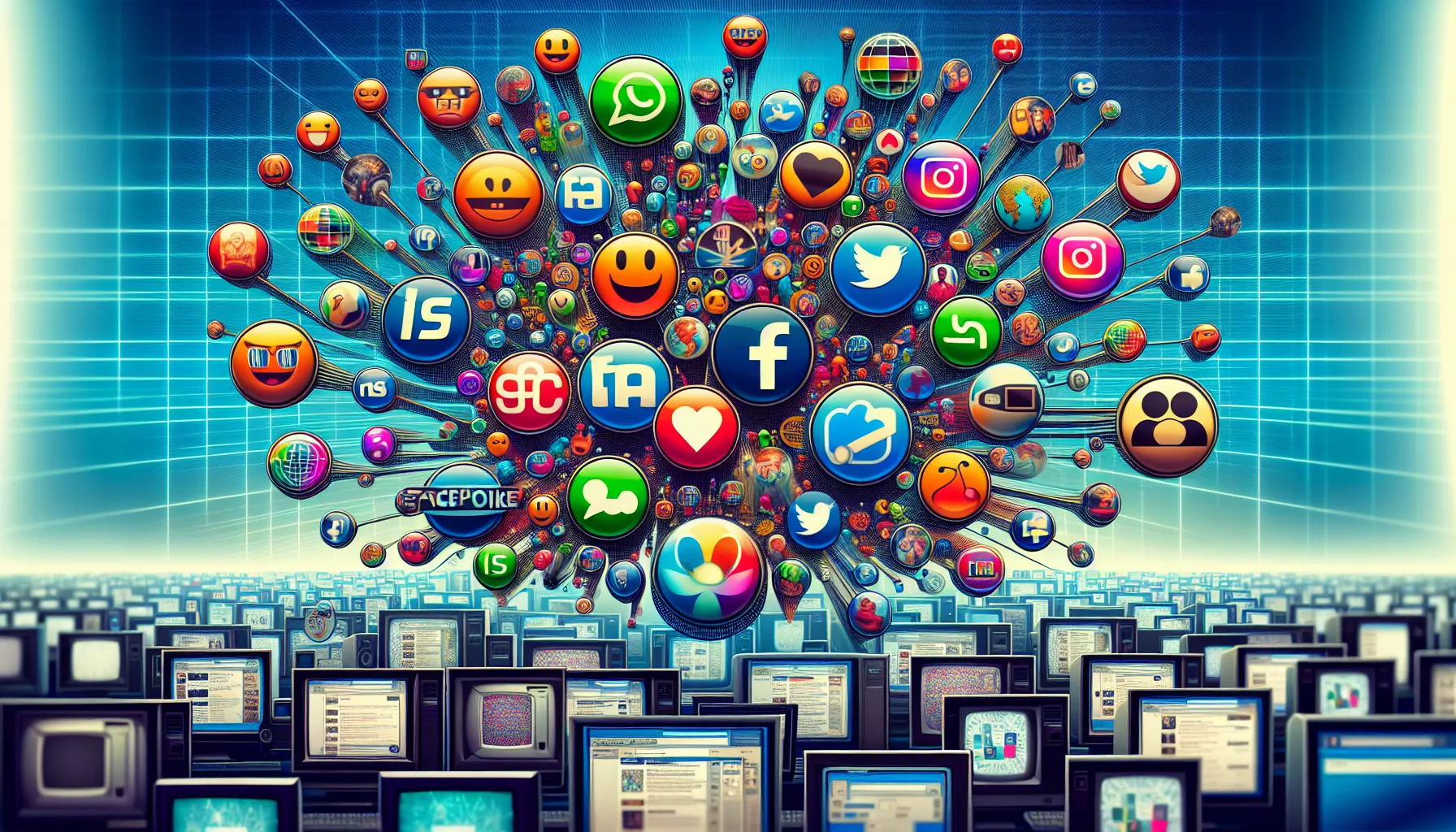Key Takeaways
- Social media’s origins trace back to early communication networks like ARPANET in the 1960s and bulletin board systems (BBS) in the 1980s.
- The launch of Six Degrees in 1997 marked the first modern social media platform, paving the way for platforms like MySpace and Facebook.
- The 2000s saw the rise of Friendster, MySpace, Facebook, and Twitter, which introduced new ways of networking and real-time communication.
- Visual platforms like Instagram and Snapchat gained popularity in the 2010s, focusing on photo-sharing, Stories, and ephemeral content.
- TikTok revolutionized social media with short, engaging videos, setting a trend that other platforms like Instagram Reels and YouTube Shorts followed.
- Social media reshaped communication, culture, and activism globally while also introducing challenges like misinformation and privacy concerns.
Social media feels like it’s been around forever, doesn’t it? It’s so woven into our daily lives that it’s hard to imagine a time before scrolling, liking, and sharing. But like all great things, it had to start somewhere—and its beginnings might surprise you.
I’ve always been fascinated by how it all began. From the early days of connecting people through simple networks to the massive platforms we use today, social media has come a long way. So, when exactly did it start, and what sparked this digital revolution? Let’s take a quick stroll down memory lane to uncover its origins.
The Origins Of Social Media
Social media’s roots go back much further than most people realize. Its development started with early communication networks that transformed how individuals shared information.
Early Forms Of Communication Networks
Early communication networks laid the groundwork for social media. The 1960s saw the introduction of the Advanced Research Projects Agency Network (ARPANET), a closed system for sharing data among researchers. In the 1980s, bulletin board systems (BBS) allowed users to post messages, share files, and form virtual communities. For example, CompuServe and Usenet enabled message exchanges and communal interests in niche topics.
The Birth Of The Internet And Its Influence
The internet significantly propelled the growth of social media. In the early 1990s, the World Wide Web opened public access to interconnected systems, amplifying online interaction. GeoCities, launched in 1994, allowed users to create personal websites, mirroring aspects of modern social media. Six Degrees, introduced in 1997, became the first platform enabling users to create profiles and connect with others directly, marking a pivotal shift toward the interconnected platforms of today.
The First Social Media Platforms

Social media began taking shape in the late 1990s with platforms that transformed online communication. These early platforms laid the groundwork for the networks we know today.
Six Degrees: The Pioneer Platform
Six Degrees, launched in 1997, is widely considered the first modern social media platform. It allowed users to create profiles, connect with others, and build lists of friends. By integrating ideas of online networking and interaction, it set the stage for future platforms. Although it shut down in 2001, its core design influenced the development of MySpace and Facebook.
The Rise Of Blogging And Forum Communities
Online forums and blogging platforms emerged in the late 1990s, offering spaces for users to share content and engage in discussions. Platforms like LiveJournal (1999) and Blogger (1999) gained popularity for self-expression and storytelling. Forums, including phpBB and vBulletin, supported topic-specific communities, fostering detailed conversations and niche group interactions. These tools expanded the scope of online engagement, bridging personal and community-building aspects of social media.
Social Media In The 2000s

The 2000s saw a rapid expansion of social media platforms, fundamentally changing how we connect and communicate. This period introduced many groundbreaking platforms that shaped the modern digital landscape.
The Launch Of Friendster And MySpace
Friendster, launched in 2002, became one of the first major social networking sites, emphasizing user profiles, connections based on friendships, and photo sharing. It quickly gained popularity, attracting millions of users within its first year. Despite its initial success, technical challenges and competition hindered its long-term growth.
MySpace, introduced in 2003, revolutionized personal expression in social media. It allowed users to customize their profiles with HTML, share music, and connect with friends. By 2006, MySpace was the most visited website in the US, highlighting its dominance in the early social media space. It became a cultural phenomenon, especially for younger audiences.
Facebook, Twitter, And A New Era Of Connectivity
Facebook entered the scene in 2004 initially as a Harvard-exclusive network. It expanded to other universities before eventually opening to the general public in 2006. Its focus on real-name profiles and connections with real-world acquaintances distinguished it from earlier platforms. By the end of the decade, Facebook had over 350 million active users.
Twitter, launched in 2006, introduced the concept of microblogging with its 140-character post limit. This platform emphasized real-time updates, hashtags, and global conversations. By 2009, it emerged as a vital tool for news dissemination and public discourse, driven by events like the Iranian election protests.
How Social Media Evolved Over Time

Social media continued evolving in the 2010s, introducing unique platforms and transforming how people interact through visual and short-form content.
The Popularity Of Visual Platforms Like Instagram And Snapchat
Instagram launched in 2010, focusing on photo sharing with filters that encouraged creativity. Its user base grew rapidly, reaching 100 million users by 2012. Acquired by Facebook in the same year for $1 billion, Instagram added features like Stories in 2016, inspired by Snapchat, to boost engagement through ephemeral content.
Snapchat, launched in 2011, introduced a new way of communicating through disappearing photo messages. By 2013, it was processing 350 million snaps daily. It gained popularity among younger audiences with features like Stories and AR filters, setting trends that competitors later adopted.
The Emergence Of TikTok And Short-Form Content
TikTok, introduced globally in 2018 after merging with Musical.ly, transformed content creation with short, music-driven videos. Its intuitive algorithm helped creators gain visibility, contributing to its rapid growth. By 2020, TikTok was downloaded over 2 billion times and became a cultural phenomenon.
Short-form videos also influenced competitors like Instagram’s Reels and YouTube Shorts. These formats kept users entertained in a fast-paced, mobile-first environment, ensuring short-form content’s dominance in social media trends.
The Impact Of Social Media On Society
Social media transformed how people communicate, share information, and build relationships. Platforms like Facebook and Twitter allow instantaneous interaction, bridging geographical distances and enabling global conversations. Communities now form around shared interests, enabling connections previously limited by physical boundaries.
Social media influences culture and trends through content creators and influencers. Popular platforms such as Instagram and TikTok promote new behaviors, interests, and lifestyles by making content easily shareable. Viral challenges, memes, and trends spread rapidly, shaping societal conversations.
Education and activism gained momentum with social media’s rise. Movements like #BlackLivesMatter and climate change campaigns gained global recognition due to this medium. By raising awareness across borders, these platforms amplify voices and promote social justice.
While fostering connection, social media also introduced challenges. Issues like cyberbullying, misinformation, and privacy concerns emerged, making safety critical for users. For example, platforms implemented moderation tools and enhanced privacy settings to mitigate harmful behavior. Social media continues to influence societal norms while adapting to address its drawbacks.
Conclusion
Social media has come a long way from its humble beginnings, evolving into a powerful force that connects people, shapes culture, and drives innovation. It’s fascinating to think about how far we’ve come and how these platforms have transformed the way we communicate and share our lives.
As we continue to embrace new trends and technologies, it’s clear that social media will keep evolving. Whether it’s fostering global conversations or sparking cultural movements, its impact is undeniable. I can’t wait to see what the future holds for this ever-changing digital landscape.
Frequently Asked Questions
What are the origins of social media?
The origins of social media can be traced back to the 1960s with ARPANET, an early communication network. Later, bulletin board systems in the 1980s allowed information sharing and community building, setting the stage for modern social media.
What was the first modern social media platform?
Six Degrees, launched in 1997, is considered the first modern social media platform. It allowed users to create profiles, list friends, and connect with others.
When did blogging and online forums become popular?
Blogging and online forums gained popularity in the late 1990s through platforms like LiveJournal and Blogger, significantly expanding avenues for online interaction and self-expression.
How did Facebook and Twitter change social media in the 2000s?
Facebook, launched in 2004, redefined personal connections and grew to over 350 million users by 2009. Twitter, launched in 2006, introduced microblogging, enabling real-time, concise communication.
What impact did Instagram and Snapchat have?
Instagram, launched in 2010, popularized visual content and gained 100 million users by 2012. Snapchat, introduced in 2011, innovated with disappearing messages and Stories, redefining communication styles.
How has TikTok influenced social media trends?
TikTok, launched in 2018, revolutionized short-form content with music-driven videos, amassing over 2 billion downloads by 2020. It inspired competitors to adopt similar short video formats, like Instagram Reels and YouTube Shorts.
How has social media transformed society?
Social media has revolutionized communication, enabling global interaction and real-time information sharing. It influences culture, supports activism, and fosters education, though it also raises concerns like cyberbullying and misinformation.
What challenges do social media platforms face today?
Platforms grapple with issues like cyberbullying, misinformation, and privacy concerns. In response, they have implemented moderation tools, enhanced privacy controls, and developed algorithms to address harmful content.
How do content creators and influencers shape trends?
Content creators and influencers drive trends by sharing engaging content that shifts cultural and lifestyle norms. Platforms like Instagram and TikTok have amplified their impact in promoting new behaviors and products.
What is the future of social media platforms?
The future will likely focus on adapting to privacy concerns, combating misinformation, and innovating formats like short videos, AR, and VR. Social media will continue to shape communication and cultural trends globally.

